Solving a long-held family history mystery leads to an enigmatic playwright
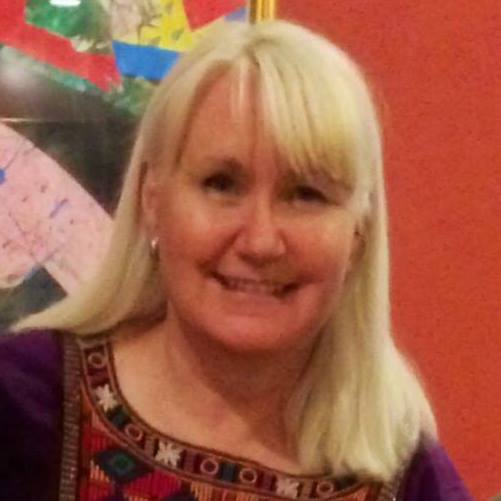
By Megan Smolenyak
I couldn’t understand it. My nana had an amazing memory. As a professional genealogist, I’m more aware than most that we should take our family lore with a grain of salt. Whether deliberately or accidentally, it’s distorted as it travels through the generations, but everything she told me had turned out to be accurate, consistently borne out through my careful research. Everything except that one story.
Nana’s Claim
Nana – known to others as Beatrice Reynolds – wed James Shields in 1923, and with that marriage came an Irish immigrant father-in-law, David Shields, who enjoyed regaling her with tales. The one she was proudest of was our relationship to Academy Award-winning actor, Barry Fitzgerald, known for his Abbey Theatre performances and film career (Going My Way, The Quiet Man, How Green Was My Valley). Barry Fitzgerald was the stage name of William Shields, and according to Nana, Barry aka William was her father-in-law’s first cousin.
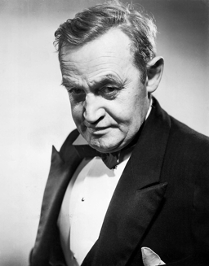
Actor Barry Fitzgerald whose birth name was William Joseph Shields
(picture by unknown, eBay, Public Domain)
As with all the other nuggets she told me, I set about proving it, but came up short. Every few years, I’d pull out my notes and have another go. No luck. Then came DNA testing. Surely genetic genealogy would help me substantiate what the paper trail couldn’t because Nana was always right.
Nope. In fact, genetic research disproved the connection. So was it wishful thinking? I mean, what Irish American wouldn’t want to claim Barry Fitzgerald in their family tree? Sadly, Nana was long gone by then, so I’d just have to live with the mystery.
My Turn
Fast forward a number of years. Because I research other people’s roots for a living, my own are neglected, but late last year, I indulged myself and took a dive into my own ancestry. My Shields branch called to me because it was the stubbiest one on my family tree, ending just a generation before my Ballymoney-born great-grandfather, David Shields – the same fellow who had been Nana’s father-in-law. David’s father’s name was William, but that was where the line ended.
So many advances have occurred in Irish genealogy in recent years that I figured I had a chance of pushing back a little further. Even so, I had tried all the usual resources, so where to begin? Newspapers. Yes, that was it. I had never methodically delved into Ballymoney-area newspapers, and little wonder since they’re not online. Plenty of Irish and U.K. newspapers have been digitized and can be searched from the comfort of our homes or local coffee shop, but not the ones I needed. Fortunately, the Internet could at least help me determine which libraries held the newspapers I was interested in, as well as steer me to professional genealogists based in County Antrim.
Extra, Extra!
After some consideration, I selected a genealogist and approached her with a list of death and marriage dates for assorted family members. Could she, I asked, search for obituaries and marriage announcements around these dates? And while she was at it, my great-grandfather, David Shields, had taken a trip back to the auld sod when he retired, almost 50 years after he had emigrated to America. It was a long shot, but could she see if perhaps the local paper had included a snippet about a hometown lad reappearing half a century after leaving? I knew the dates he arrived and departed so could narrow the timeframe. She agreed.
Several weeks later, the report arrived. My family, it emerged, didn’t rate, so there was only one obituary, but darned if the long shot didn’t pay off. The genealogist found an article about my great-grandfather’s visit that mentioned him as David Shiels, rather than Shields, the name he used in America. This was the first clue. The write-up also remarked that he was a native of Coldagh, another critical lead. Shiel(d)s was a common name in Ballymoney, so zeroing in on Coldagh could help narrow the field of possible relatives.
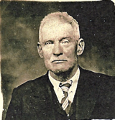
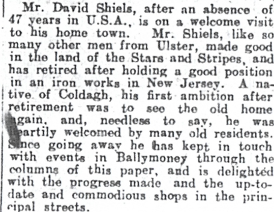
Puzzle Pieces
Armed with these new details, I searched conventional resources – mostly Irish census and births, marriages, and deaths in both government and church records – for any variation of Shiel(d)s associated with Coldagh (including Sheals, Sheils, Shiells, Shales, etc.). In a sense, I was constructing an ancestral jigsaw puzzle, only I had to hunt down each of the pieces first. It was tedious, yes, but as I linked this person with that, an extended family tree began to take shape hinting that all the Coldagh Shiel(d)s might be related one way or another.

Plodding through this process, I flashed back to a minor mystery that had bothered me for years. My great-grandfather, David, and his wife had been godparents to a Shields youngster in Jersey City, New Jersey in 1894, but I couldn’t place the child. I had ruled out the baby’s father, Joseph, as a brother of David’s, so had supposed that he was a cousin, but my efforts to trace Joseph further had come to nothing. I wondered if I might have more success now.
What’s New?
Just as valuable Irish genealogical collections have materialized online in recent years, so have others on this side of the Atlantic, such as New York City Catholic records (still in the process of being released by FindMyPast). Since I hadn’t been able to find Joseph’s marriage in New Jersey, I thought New York might hold the answer, and to my delight, it did. Better yet, the record gave the name of Joseph’s father: Robert.

This might seem like a trivial detail, but I was excited because the name Robert was rare among the Shiel(d)s of the Ballymoney area. Re-examining census records I had gathered, it took just moments to find Robert in the 1901 census with his wife and some of their children. Joseph was already in America, so wasn’t included, but I had patched him into this nuclear family through birth records earlier.
Two of the larger chunks of the genealogical jigsaw I had been piecing together were my own line – David’s – and this one. Both had been Coldagh-based, so I suspected a connection, but now I had a solid theory. It appeared that David and Joseph were indeed first cousins. If I could substantiate this, I’d have a breakthrough that would allow me to push back another generation.

Double Checking with DNA
After working the paper trail with some intensity, I didn’t think there was much more to ferret out, so pivoted to DNA. I’ve been involved with genetic genealogy since the early days – about 20 years – but again, hadn’t had much time to pursue my own family. I hoped that a useful variety of distant Shiel(d)s kin might have tested in recent years – enough to help me confirm or refute my hypothesis.
I waded into the long-established genetic testing companies – Ancestry, 23andMe, and Family Tree DNA – to play the cousin-seeking game. Ancestry offered a handful, but I could account for them. If you were my second cousin, I already knew about you because we shared a pair of great-grandparents. I was on the lookout for people a couple of generations beyond, and both 23andMe and Family Tree DNA popped up individuals with Shiel(d)s and/or Ballymoney roots in the sweet spot I was aiming for – third to fifth cousins or so.
At this point, I meshed the genetic and the genealogical by building out the family trees of these new found DNA cousins and looking for ways to patch them into the jigsaw I had constructed. Much to my relief, all the pieces fit and supported the David-and-Joseph-as-cousins notion. Just as importantly, there were no strays whose genetic relationship couldn’t be accounted for by the sprawling tree. As best as I could sketch out, we were all descended from a man named John Sheals who was born in the early 1800s.
By George!
Now that I had the big picture, I allowed myself the luxury of learning more about my fresh batch of Shiel(d)s cousins. Genealogy involves countless names, dates, and places, but the real fun is discovering your ancestors as living, breathing people. So I circled back to Joseph, who had asked David – his first cousin and my eventual great-grandfather – to be the godfather of his first born.
Revisiting the 1901 census for Joseph’s parents and siblings, I noticed his brother George. He jumped out because googling “Ballymoney” and “Shiels” or even “Shields” produces a series of links for a playwright named George Shiels. Could this be that same George? It didn’t take much effort to ascertain that it was.
Huh. I had a playwright cousin. A first cousin three times removed to be precise. It wasn’t Barry Fitzgerald, but still, what Irish American wouldn’t want to claim a playwright? So what was his story? What had he written?
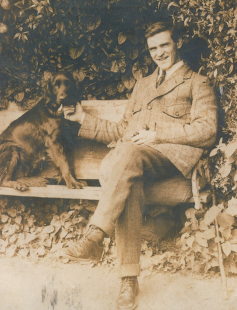
George Shiels
George Shiels
Trying to answer these questions, I got sucked into yet another research vortex from which I have yet to escape. George Shiels, it turns out, was a reclusive man and somewhat controversial writer.
Like many of his countrymen, he emigrated to North America, but was injured in a railroad accident in Canada. George returned to Ballymoney confined to a wheelchair, a situation which limited his options and led him to try his hand at writing. When short stories about his adventures in the new world failed to gain traction, he shifted to plays.
The first was produced in 1918 and three short years later, his work was being performed by the Abbey Theatre in Dublin. In 1922, he had his first major success with Paul Twyning, which the Abbey staged a total of 20 times between 1922 and 1943. He followed this hit with a steady stream of plays – approaching one per year – until his death in 1949.
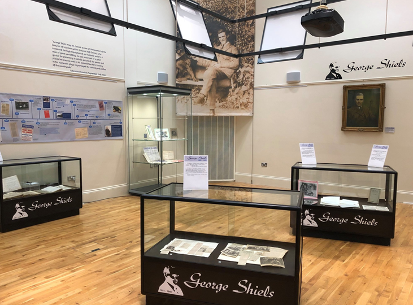
In spite of this, George Shiels is little remembered beyond his native Ballymoney where the local museum recently mounted an exhibit to commemorate the 70th anniversary of his passing. This may be due to some dismissing his work as situational comedy – hackneyed and wrapped up in a tidy bow at the end. And yet, his plays were indisputably popular with the public, and others have rallied to his defense, including Ria Mooney, the Abbey Theatre’s first female producer, who referred to him as the Irish Molière.
So is this criticism fair or just snobbery? This American cousin is in the process of securing and reading his works to decide for herself, but is optimistic on his behalf due to commentary such as this from Paul Murphy in the Autumn/Winter 2010 issue of Irish University Review:
“Shiels’ lack of engagement with the Dublin literati, due of course to the logistical limitations forced upon him by his disability, would play a part in his eventual marginalisation from the national canon of dramatic literature. Despite his physical limitations, Shiels went on to produce a body of work that would span the theatrical gamut; from broad matrimonial farce to state of the nation renditions, on to searing social realism and plays that were polemical indictments of the status quo.”

It bears mentioning as well that the value of his literary contributions aside, George Shiels made his mark on the Irish dramatic scene by helping keep the then-struggling Abbey Theatre open during the 1930s and 1940s. When Ernest “Ernie” Blythe, one-time director of the theater suggested taking a rest from George Shiels’ plays, it was none other than William Butler Yeats who replied, “A rest? And close the place!”
Close Enough
Nana had told me for years that we were related to Barry Fitzgerald, the actor whose birth name was William Shields, but the truth is that we were related instead to playwright George Shiels. The source of the confusion? For one, at the time her father-in-law, David Shiel(d)s, was claiming famous kin, George Shiels – who really was his first cousin – was the more prominent of the two. Both men also had a long association with the Abbey Theatre. Not long after David passed in 1936, Barry Fitzgerald’s star began to rise while George Shiels’s started to fade, prompting the memory wires of the living to cross.
And then there was this: That first hit play of George’s staged at the Abbey? The title character was played by a little known daytime bureaucrat and nighttime thespian who was also enjoying his first major success – a fellow by the name of Barry Fitzgerald. Nana might not have been completely right, but she wasn’t far off the mark. It just took her granddaughter longer than it should have to sort the wheat from the chaff.

Megan Smolenyak, a long-time genealogist and writer, dedicated this piece “to Aunt Bea for waiting decades for me to unravel the truth in her mother’s favorite ‘tall tale.’”
Megan’s celebrity roots research includes the Obamas, Joe Biden, Hillary Clinton, Megan Markle, Judy Collins, Lin-Manuel Miranda, Stephen Colbert, Brooke Shields, Cory Booker, Susan Sarandon, Jimmy Fallon, Melissa McCarthy, Bruce Springsteen, Emmitt Smith, Richard Blais, Betty White, Katy Perry, Beyoncé, Josh Groban, Pink, Ken Burns, Prince, Jon Stewart and Bruno Mars. One of her most famous genealogical research projects includes tracing President Obama’s roots to Moneygall.
Follow Megan on Facebook, Twitter, Pinterest and YouTube. To learn more about Megan and her work visit her website megansmolenyak.com.

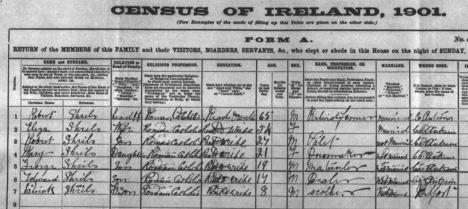
Leave a Reply